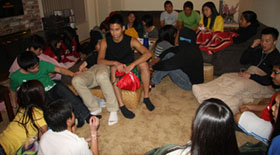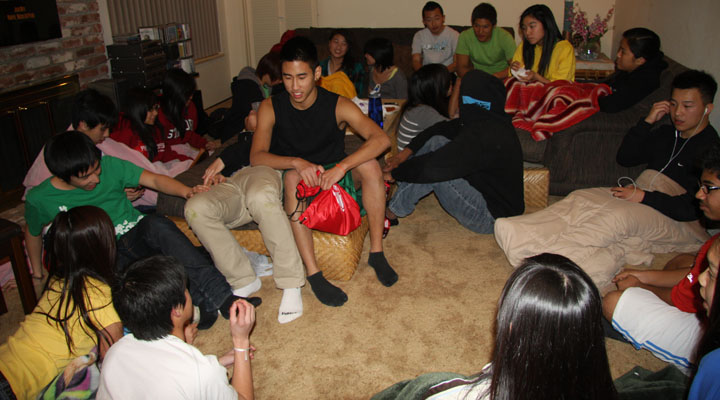
The club began with about 70 members; now, the former Friends of Hue Foundation, after
over the summer of 2011, has 30 regulars.
But IYAA is not quite akin to other clubs — the club doesn’t meet on campus.
IYAA began to gradually distance themselves from the school in order to better accommodate the direction in which the club had shifted: members from six different schools participate in team-based activities, while simultaneously preparing for an annual summer trip to the Xuan Phu Shelter in Hue, Vietnam, where they provide aid to the orphans that reside there. IYAA felt that the nature of a scholastic club limited such a collaborative experience. Since Jan. 14, the club has met weekly on Saturdays at club leader senior Hikaru Asao’s house, although they officially remain as an MVHS club for the time being.
Abolishing officers
The transition away from campus was partially motivated by an incompatibility with the hierarchical structure involving officers that clubs must adhere to, as per Club Commission’s requirements. Now focused more on personal growth and identity-seeking than community service, IYAA finds the hierarchy superfluous. According to club leader senior Scott Hyon, the officer-member dynamic hindered involvement of the latter party — members would follow officers’ instructions without actively participating in meetings or the decision-making process regarding the club’s agenda. As such, after three other officers left the club, former officers Hyon, Asao and junior Emily Liu did away with their positions entirely.
“We feel like we’re being trapped by the kind of structure that they’re trying to set: There has to be a president, there has to be a vice president, there have to be three other officers,” Hyon said, regarding the impetus for the club’s ongoing removal from campus. “For us, we don’t feel like that fits.”
Hyon added, however, that they soon found the lack of leadership to be ineffective.
“We wanted everyone’s input, so we got rid of officers, just to see how it was going to go,” Hyon said. “We wanted people to contribute, but it didn’t happen like that; obviously, when everyone is equal, no one knows where to go for leadership.”
Creating leaders
The club established “leaders” — ten at first, now narrowed down to four, including Hyon, Asao, Liu and Homestead High School senior Varun Dupuguntla — to guide meetings and coordinate activities and projects. According to Hyon, the leaders differ from officers in that the former encourage member involvement to a greater extent than the latter.
“[Officers would] decide what to do, and they’d give it to the members to do, and the members don’t really understand what’s going on. But the four leaders would be coming up with what needs to be accomplished, explaining to the members what needs to be accomplished, and why it needs to be accomplished … [Leaders] make decisions based on everyone’s input,” Hyon said.

Each leader takes upon a team, units in which club members will function for the remainder of the year. The four teams compete and collaborate in character-building and bonding activities, like scavenger hunts, while preparing for their trip to Vietnam in June 2012.
Scholastic distractions: an inconvenient venue
Asao, Hyon and Liu also found MVHS ill-suited to their club’s needs because of the academic distractions that meeting at a school entail — students thoughts tend to focus on math tests rather than the club, Liu said.
“Everyone is worrying about something else at school,” Asao said. “They come and we talk about something, and they realize something, but then they go to their next class … they forget.”
Liu added that meeting outside of school at Asao’s house allows them to ponder the content discussed, even after the meetings.
The expansive nature of IYAA also rendered meeting during school hours difficult; as the club spread through word-of-mouth to encompass students from different schools, meeting at MVHS was not viable. Nor did the club leaders find activities such as Club Promo Day particularly beneficial — they believe that the somewhat intangible nature of the club’s philosophy would be difficult to convey during such an event.
“We can’t really describe our club in I guess just one sentence,” Liu said. “We try to and we try to put it down in one idea … but we’re doing so many things in this club that it’s kind of hard to just tell someone.”
The new direction
IYAA’s gradual and anticipated withdrawal from MVHS aligns with their goals, which are two-fold: to spend the year developing positive character attributes, and to travel to the Hue orphanage in the summer and instill said values in the children there. The club aims to achieve the former goal by participating in a variety of character-building activities, which they liken to a year-long Challenge Day — for example, members participated in the San Jose Bike Party on Jan. 20, during rainy weather in order to foster self-discipline and hardiness.
“From identity comes confidence, comes ambition, comes understanding of other people.”
– IYAA club leader senior Scott Hyon
According to Hyon, the specifics of the club’s mission are subject to change as their framework continues to evolve. Nonetheless, he believes that their core philosophy involves coming to terms with one’s own identity.
“[We want] everyone to be comfortable with who they are and [to recognize] the kind of person they are … that’s what we want everyone in the club to see and everyone in the shelter to see,” Hyon said. “From identity comes confidence, comes ambition, comes understanding of other people.”








